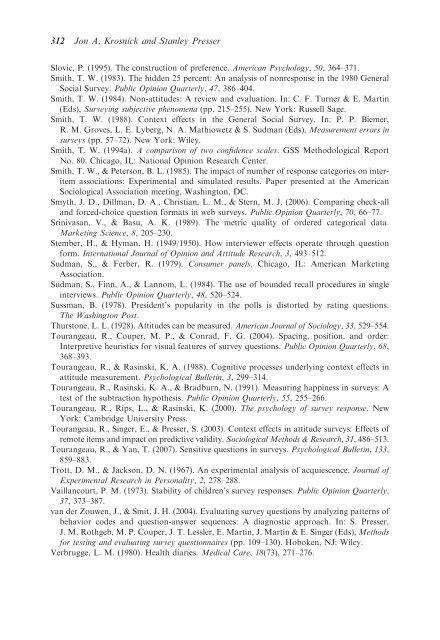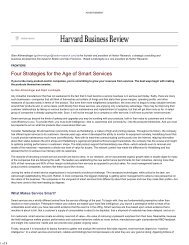Question and Questionnaire Design - Stanford University
Question and Questionnaire Design - Stanford University
Question and Questionnaire Design - Stanford University
You also want an ePaper? Increase the reach of your titles
YUMPU automatically turns print PDFs into web optimized ePapers that Google loves.
312 Jon A. Krosnick <strong>and</strong> Stanley PresserSlovic, P. (1995). The construction of preference. American Psychology, 50, 364–371.Smith, T. W. (1983). The hidden 25 percent: An analysis of nonresponse in the 1980 GeneralSocial Survey. Public Opinion Quarterly, 47, 386–404.Smith, T. W. (1984). Non-attitudes: A review <strong>and</strong> evaluation. In: C. F. Turner & E. Martin(Eds), Surveying subjective phenomena (pp. 215–255). New York: Russell Sage.Smith, T. W. (1988). Context effects in the General Social Survey. In: P. P. Biemer,R. M. Groves, L. E. Lyberg, N. A. Mathiowetz & S. Sudman (Eds), Measurement errors insurveys (pp. 57–72). New York: Wiley.Smith, T. W. (1994a). A comparison of two confidence scales. GSS Methodological ReportNo. 80. Chicago, IL: National Opinion Research Center.Smith, T. W., & Peterson, B. L. (1985). The impact of number of response categories on interitemassociations: Experimental <strong>and</strong> simulated results. Paper presented at the AmericanSociological Association meeting, Washington, DC.Smyth, J. D., Dillman, D. A., Christian, L. M., & Stern, M. J. (2006). Comparing check-all<strong>and</strong> forced-choice question formats in web surveys. Public Opinion Quarterly, 70, 66–77.Srinivasan, V., & Basu, A. K. (1989). The metric quality of ordered categorical data.Marketing Science, 8, 205–230.Stember, H., & Hyman, H. (1949/1950). How interviewer effects operate through questionform. International Journal of Opinion <strong>and</strong> Attitude Research, 3, 493–512.Sudman, S., & Ferber, R. (1979). Consumer panels. Chicago, IL: American MarketingAssociation.Sudman, S., Finn, A., & Lannom, L. (1984). The use of bounded recall procedures in singleinterviews. Public Opinion Quarterly, 48, 520–524.Sussman, B. (1978). President’s popularity in the polls is distorted by rating questions.The Washington Post.Thurstone, L. L. (1928). Attitudes can be measured. American Journal of Sociology, 33, 529–554.Tourangeau, R., Couper, M. P., & Conrad, F. G. (2004). Spacing, position, <strong>and</strong> order:Interpretive heuristics for visual features of survey questions. Public Opinion Quarterly, 68,368–393.Tourangeau, R., & Rasinski, K. A. (1988). Cognitive processes underlying context effects inattitude measurement. Psychological Bulletin, 3, 299–314.Tourangeau, R., Rasinski, K. A., & Bradburn, N. (1991). Measuring happiness in surveys: Atest of the subtraction hypothesis. Public Opinion Quarterly, 55, 255–266.Tourangeau, R., Rips, L., & Rasinski, K. (2000). The psychology of survey response. NewYork: Cambridge <strong>University</strong> Press.Tourangeau, R., Singer, E., & Presser, S. (2003). Context effects in attitude surveys: Effects ofremote items <strong>and</strong> impact on predictive validity. Sociological Methods & Research, 31, 486–513.Tourangeau, R., & Yan, T. (2007). Sensitive questions in surveys. Psychological Bulletin, 133,859–883.Trott, D. M., & Jackson, D. N. (1967). An experimental analysis of acquiescence. Journal ofExperimental Research in Personality, 2, 278–288.Vaillancourt, P. M. (1973). Stability of children’s survey responses. Public Opinion Quarterly,37, 373–387.van der Zouwen, J., & Smit, J. H. (2004). Evaluating survey questions by analyzing patterns ofbehavior codes <strong>and</strong> question-answer sequences: A diagnostic approach. In: S. Presser,J. M. Rothgeb, M. P. Couper, J. T. Lessler, E. Martin, J. Martin & E. Singer (Eds), Methodsfor testing <strong>and</strong> evaluating survey questionnaires (pp. 109–130). Hoboken, NJ: Wiley.Verbrugge, L. M. (1980). Health diaries. Medical Care, 18(73), 271–276.
















